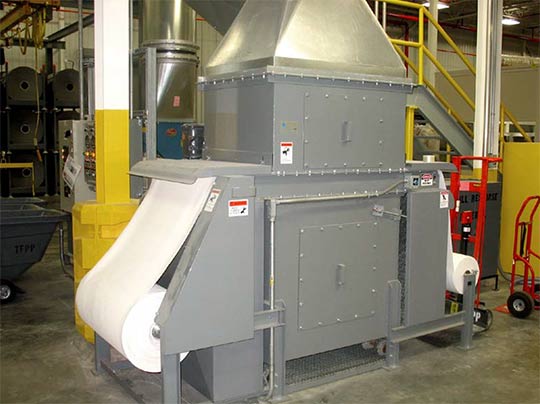
A large packaging company was expanding a plant and adding an extrusion line for rigid packaging products. From experience at another plant, it was known that a few pounds per hour of waxy particulate would be emitted from the new line – at the die and from the extruder vent.
The UHF® filter unit is specifically designed for applications such as these with very fine, sticky fumes and particulate. The unit utilizes dry filter media, presented in rolls that provide high control efficiency (i.e., high 90%’s) on submicron particulate. The filter unit maintains steady air flow by automatically indexing a clean section of filter media into the filtration chamber when the previous filter section becomes caked with particulate. The unit thus operates within a steady differential pressure band (and thus steady air flow rate band) until the entire roll is spent. Filter roll replacement takes approximately 5 – 10 minutes and is completed while the unit and process are running, a necessity for the 24/7 plant, as with many plants. The unit requires very low attention from operating and maintenance staff, as it is simple in design and automated.
The company installed two APC Technologies UHF® filter units, one on the die exhaust and one on the extruder vent. To minimize deposit of the waxy particulate in the duct, the unit for the die emissions was located on a mezzanine level just two feet above the die exhaust hood, with the exhaust flowing upward into the bottom of the filter unit. The exhaust air flows upward through the filter media then exits out the top right side of the unit.
The units were installed with variable frequency drives (VFDs) on the fan motors, allowing dial up / down of the fan speed, as the optimal amount of exhaust air flow was not originally known. After passing through the unit, the cleaned air passes through the exhaust fan and out a stack. There are no visible emissions (opacity) from the stack, nor any material deposits of any kind around the stack.
Subsequent to the installation of the two units described above, the company since installed a third unit at another plant.